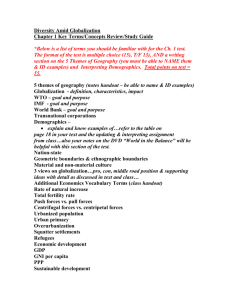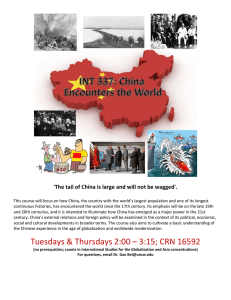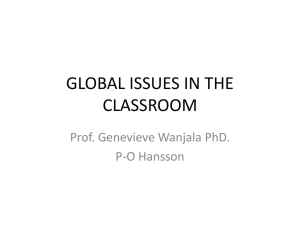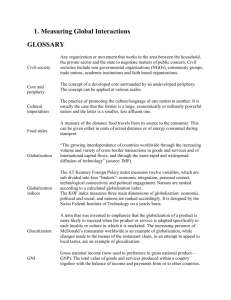July 2005
advertisement
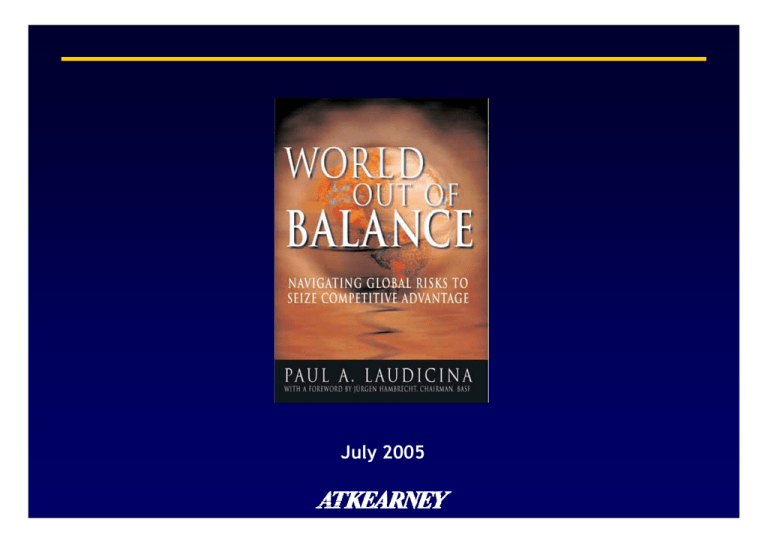
July 2005 Introduction to Scenario Planning Overview of the Five Global Drivers Scenarios & Wildcards Navigating Global Risks 1 While the opportunities of globalization have grown Trade barriers are steadily on the decline W. Avg. US Tariff Rate 3.0 2.5 2.0 1.5 1.0 5 4 3 2 1 2001 2000 1999 1998 1997 1996 1995 1994 1993 1992 1991 2002 2001 2000 1999 1998 1997 1996 1995 1994 1993 1992 1991 1990 0 0.0 1989 0.5 1990 Globalization Index, Weighted A.T. Kearney’s Globalization Index So have the risks Computer viruses cause more damage in less time Economic Damage Damage of of Viruses, Viruses, Economic $US, millions millions $US, Terrorist incidents are increasingly common 3000 2500 2000 1500 1000 500 9 Hours 2400 1800 1200 12 Hours 600 150 3 Days Years 10 Minutes 2 Days 0 0 1997 1999 2001 2003 Jerusalem Concept Melissa Love Code SQL (1990) (1995) (1999) Bug Red Slammer (2000) (2001) (2003) 2 Successful companies must anticipate and manage change according to the key drivers of the global operating environment Globalization Consumption Patterns Demographics Technology & Innovation Natural Resources & Environment Regulation & Activism Wildcards • Low probability, high impact, disruptive events 3 Example: globalization - is an integrated world at risk? Projected Globalization, 2003-2015 Continued Growth? 50 Globalization Index, weighted 45 Growth in globalization, 1990-2003 Stagnation? 40 35 Decline? 30 25 20 15 10 1990 1992 1994 1996 Source: A.T. Kearney Globalization Index, 2005 1998 2000 2002 2005 2010 2015 4 For each driver, we model the component parts Globalization • • • • Economic Integration Technological Connectivity Personal Contact Political Engagement Demographics • • • • Population Growth Age Dependency Ratio Gender Imbalances Infectious disease Consumption Patterns • • • • Size of the overall consumer market Income distribution & the middle class Local tastes Consumption trends Regulation & Activism • • • • Government liberalization Corporate image Stakeholder activism Corporate social responsibility Natural Resources & the Environment I llu stra ti ve • Resource Scarcity (oil, water) • Energy Dependence • Environmental Degradation 5 Scenarios are built from the ground up Driver: Indicators: I llu stra ti ve Globalization • Economic Integration • Political Integration • Social Networking • Technology Gap Sub-Scenarios: “National Guard” “Near Abroad” “Davos Man” 6 Macro-Scenarios are developed from a combination of sub-scenarios and span the continuum of future possibilities I llu stra Generate Scenarios Macro Drivers Indicators • • • • Globalization Economic Integration Political Integration Social Networking Technology Gap • Growth and Distribution • Wealth Accumulation • Familial Piety Demographics Sub-Scenarios Continued Gap Slow Integration One Europe Street War Guarded Acceptance Home, Sweet Home ti ve Scenarios 1 "Regional Polarity" 2 “Melting Pot" Management Uses Scenarios as Guidelines • • • • Prepare risk and action plans for the different scenarios Observe drivers and other “road signs” along the way Adopt scenarios and plans to changes in the environment Restructure business to changing environment 7 “Powerfully imagined and rigorously researched…scenarios are an indispensable guide to decision-making in an environment of new risks & opportunities”* Drivers Globalization Full-Spectrum Scenarios for the World in 2015 Open Borders, Lingering Castles and Moats Patchwork World Fears (Optimistic) (Pessimistic) (Baseline) National Guard: Near Abroad: Davos Man: perceived external globe settles in for long world growth and threats to security fuel haul of low intensity confidence continue as nationalism conflicts does global integration Demographics Urban Time Bomb: young, poor populations combust while aging hits West Safety Valve: rich countries are “gated communities” with limited immigration Consumption Patterns Discount Warehouse: weak growth restrains middle class size in emerging countries Multiplex: Affluent Individualism: consumption spans a wide world of savvy, spectrum - standardization sophisticated consumers to customization Natural Resources & Environment Toxic Shock: resource competition and regional conflicts Search for Alternatives: some regional instabilities and ecological concerns Abundance Renewed: new reserves and technologies come on line Regulation & Activism New Dirigisme: populist governments and militant activists Selective Re-regulation: “rational” government action & self-correction Back to the 80s: forces of commerce and technology overpower restraint * John Gray, School Professor of European Thought, London School of Economics Adaptive Labor Market: intelligent immigration policies improves prospects 8 Introduction to Scenario Planning Overview of the Five Global Drivers Scenarios & Wildcards Navigating Global Risks • Globalization • Demographics • Consumption Patterns • Natural Resources & the Environment • Activism & Regulation 9 Globalization Globalized countries tend to be rich, free and open 2005 Globalization Index Top 10 Economic Personal Technology 2005 Globalization Index Bottom 10 Political Economic Singapore Peru Ireland China Switzerland Venezuela, RB United States Turkey Netherlands Brazil Canada Bangladesh Denmark Egypt, Arab Rep. Sweden Indonesia Austria India Finland Iran Source: A.T. Kearney Globalization Index 2005 Personal Technology Political 10 Demographics The developing world will comprise virtually all future population growth Population trends in developed and developing countries (1750 – 2100) Total World Population Developing Regions Developed Regions 12 Population (billions) 10 8 6 4 2 0 1750 1800 1850 Source: Population Reference Bureau, U.S. Census Bureau 1900 1950 2000 2050 2100 11 Demographics Developing countries will be urban and young Mega Cities 2015 5-8 million 8-10 million > 10 million Developing countries in 2020 show a youth explosion… …while industrialized populations are aging rapidly Age Groupings 2020 Age Groupings 2020 75+ 75+ 60-74 60-74 45-59 45-59 30-44 30-44 15-29 15-29 0-14 0-14 Males -20 Source: US Census Bureau -10 0 Females 10 20 -30 -10 Males Females 10 30 12 Demographics A convergence of forces is creating a new global market for talent Talent Shortage in the West Global Market Liberalization Technology Driven Innovation And Productivity Shift From Manufacturing To Services Economy Skills Development in Emerging Markets 13 Consumption Patterns Middle class growth will be largely in the developing world 2000 2015 UK South Korea Ireland Canada Japan Canada 56m United States 68m Ireland Scandinavia UK 71m United States 84m Scandinavia Benelux 145m 70m Japan 49m Baltics 36m 82m Germany 40m 21m Spain Mexico South Korea Russia France East Turkey Europe Iran 9m Benelux Germany 18m 30m France China 76m Hong Kong Mexico 27m 19m Taiwan Central America Colombia Portugal Chile Israel India Thailand Malaysia Singapore 23 m 5.5m 4.3m Russia 595m East Europe Turkey 82m Iran Northern Africa Central America Philippines Colombia Indonesia South Africa Argentina Italy New Zealand Peru Chile Pakistan Portugal Brazil Australia 24m Thailand Caribbean Venezuela 39m 24m Spain Venezuela Brazil Peru Italy Caribbean China 33m 9m 9m Israel Northern Africa India Taiwan Hong Kong Vietnam Malaysia South Africa Singapore Philippines Indonesia Australia Argentina New Zealand 10 million consumers Middle Income Source: World Bank, EIU, US Census Bureau and A.T. Kearney analysis Upper Middle Income Upper Income 14 Consumption Patterns Consumption patterns are shifting Advanced Markets: More Experiences Emerging Markets: More Stuff High-end, luxury goods Status-oriented merchandise Custom features and add-on´s Electronics Individualized leisure activities and entertainment options Consumer durables New vehicles Housing Travel and tourism Vacation homes Concern for health, longevity Growing ecological awareness Source: Dr. John Quelch 15 Consumption Patterns Local culture will also drive consumer preferences United States English Canada French Quebec Time Do it now Wait The past Energy Superman Winter energy Frustration Space The universe The best place on earth Shrinking or under siege The Logic of Emotion Life, liberty and the pursuit of happiness Peace, order, and good government Je me souviens or a sense of remembrance The Body A machine An inconvenience For pleasure Food A machine Maintenance Enjoyment Eating Fill up the tank Keep life going An orgy Source: Dr. G. Clotaire Rapaille, Archetype Discoveries 16 Natural Resources Four key factors will drive future energy markets Politics Technology • Development of situation in Iraq • Extractive technology • Central Asian regime stability • New efficiencies • OPEC cohesiveness • Alternative energy technology Economics Environment • Consolidation of oil markets and firms • Degree of observable climate change • Asian economic development • Availability of natural resources • Central Asian macroeconomic stability 17 Natural Resources The future will be increasingly characterized by concerns over water scarcity and water stress 2000 Water Availability 2050 Water Availability As Percent of World Population As Percent of World Population Stress 5% Scarcity 3% Stress 24% Sufficiency 92% Sufficiency 58% Sources: CGIAR = consultative group on international agricultural research& ÍWMI = international water management institute Scarcity 18% 18 Natural Resources The reality of global climate change is now universally acknowledged Temperature Change, °C 1.0 0.8 0.6 0.4 0.2 0 -0.2 -0.4 -0.6 1866 Sources: Scientific American, NASA 1899 1932 1965 2002 19 Activism & Regulation Complex regulatory issues challenge constrained governments… Issues at the frontier Digital technology & privacy issues E-commerce Biotechnology Stem cell research and human cloning U.S. Government “Brain Drain” Public Sector Retirement Eligibility, 2005 Eligible 45 % Genetic testing raises medical privacy concerns • Nearly half the senior executives in the US government may soon depart Source: Council on Excellence in Government 20 Activism & Regulation …while empowered activists challenge corporate behavior Transnational networking • Low cost of global transportation and communication • Decentralized organizations disseminate information rapidly and efficiently Brand image exploited by activists Brand “boomerang” tactics Brand editing • Profusion of brand names and identities allows activist groups to educate and instigate consumers 21 Introduction to Scenario Planning Overview of the Five Global Drivers Scenarios & Wildcards Navigating Global Risks 22 Each scenario has its own set of implications Implications under Open Borders, Lingering Fears Full-Spectrum Scenarios for the World in 2015 Drivers Castles and Moats Patchwork World Open Borders, Lingering Fears Globalization Rise of localization Bilateral half-measures Homo economicus Demographics Restless masses Immigration queue Global talent flow Consumption Patterns Rice and beans World bazaar Hey, big spenders Natural Resources & Environment Constrained energy Necessary innovation Fuel for growth Regulation & Activism Big Brother is watching Partial restraint Chicago boys II The US and China are the dominant economic and political players on the world scene Increased trade and investment openness boost international business activity and technological innovation, but several thorny regulatory and governance issues remain. Rising affluence of consumers, with growing middle class in emerging markets Industrialized countries become more open to immigrant workers due to aging workforce 23 Insights derived from the scenarios can be quantified and driven down to the level of geographic markets and key customer industries 24 Wild Cards “Wildcards” must also be considered Wild cards are low-probability, extremely high-impact events that: (1) (2) (3) (4) directly affect the human condition; are potentially disruptive (negatively or positively); are intrinsically beyond the control of any institution, group or individual; are rapidly moving Global War Country New Epidemic Erupts Disintegration Mercantilism Source: The Arlington Institute, A.T. Kearney Analysis Terrorist Resurgence Hacker Quantum Hell Leap 25 Introduction to Scenario Planning Overview of the Five Global Drivers Scenarios & Wildcards Navigating Global Risks 26 In this rapidly changing business world, corporations face an increasingly complex risk environment Greatest risks impacting FDI decisions, 2004 64% Government regulation/legal decisions Country financial risk 60% Currency/interest rate volatility Political & social disturbances 46% Corporate governance issues 30% Absence of rule of law 29% Theft of intellectual property 28% Terrorist attacks 26% Security threats to employees/assets 26% Disruption of key supplier/customer/partner 20% IT disruption 19 % Employee fraud/sabotage Activist attacks on global/corporate brands Source: A.T. Kearney Foreign Direct Confidence Index Emerging Risks 23% Product quality/safety problems Natural disasters Traditional Risks 5 1% 10 % 6% 5% 27 S&P 500 Directors fear they are unable to properly assess emerging global risks and opportunities Percent S&P 500 Directors Rating Board as “Very Effective” 50 49% 43% 40 30 24% 20 21% 16% 15% 10 0 Probing Problems Source: A.T. Kearney Analysis Monitoring Leadership Guiding Financials Development Strategy Monitoring Performance Risks Warnings 28 Lack of appropriate tools and objective information are seen as the biggest impediments to effective strategy and risk monitoring What are the impediments to monitoring business performance? (% of directors ranking in top 3) Regular, independent, third-party reviews of governance practices: 41% Should Have: Do Have: Yes 24% 19% 17% 21% 23% Yes 55% No 45% N/A 1% No 75% Directors do not have enough time Insufficient Board Amount and Lack of tools/ operating Culture type of processes mgmt. company providing early discussions information warning signs Source: A.T. Kearney Analysis 29 Managing risk requires five key steps 1 3 2 Prioritize earnings drivers Examples Identify critical infrastructure 4 Locate vulnerabilities 5 Develop responses Monitor the risk environment Risk responses Priority sourcing locations Illust r —Intellectual Property —Delivery & Logistics Key Characteristics —Raw Materials & Inventory Not considered On “to do” list ative Implementing Flexible —Personnel & Customer Support Redundant —IT & Telecom Systems Strategic —Manufacturing, Plant & Equipment Collaborative Key Port/Node Flow of Goods 30 A risk/response matrix should be agreed upon to define the responses required at each level of risk Risk/response matrix for procurement/sourcing operations Risk Level* Profitability Impact Action Required Severe High High High Elevated Moderate Guarded Moderate Low Moderate Operations in affected country to be stopped immediately Action plan for diverting operations to be created within 1 month Explicit risk mitigation/diversification strategy to be created within 1 month Report on key risks to be submitted; validation of current strategy Regular risk monitoring Accountability / Report Level CEO and Executive Team CPO Legal, Financial Departments Procurement and Supply Chain leadership team Regional Sourcing Managers Category Managers Risk audit core team * Sample gradations; additional complexity can be incorporated in model, including probabilistic distribution, variability in risk assessment, etc. 31
